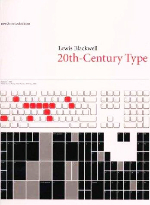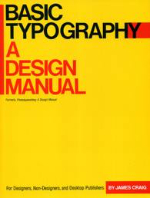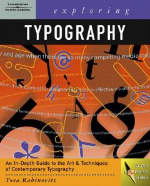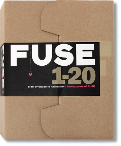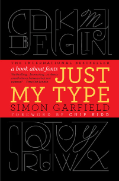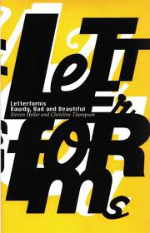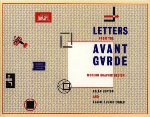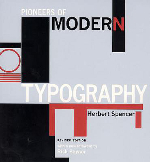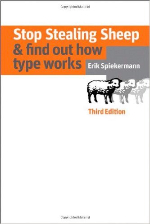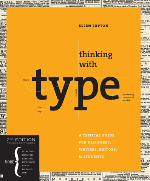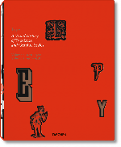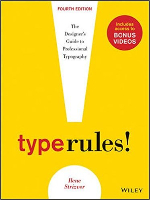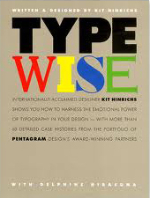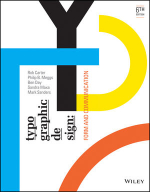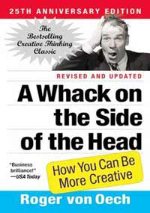With a fairly extensive library of books, I am listing a few of my favourites; many of which deal specifically with typography or graphic design. They are listed in alphabetical order by book title, and not in order of any
personal preference.
20th-Century Type
by Lewis Blackwell
This book showcases a number of 20th-century types and is more of an image book than instructional book on type. It shows some of the changes and evolution of type which occurred last century. The updated version covers type on screen and in particularly
the internet.
Avant-Garde Page Design
by Jaroslav Andel
With networked computers gradually replacing printed pages as the primary carriers of information, we are witnessing a full-scale transition in the way we communicate. In order to more fully understand the cultural significance of this technological revolution, artists, designers, and scholars are beginning to re-examine the history of printed material. Andel’s scholarship shows how even the earliest experimenters coined innovations that remain powerful conventions of page design today, and how some, such as El Lissitzky, actually predicted the rise of electronic media.
Basic Typography, A Design Manual
by James Craig
This book was published in 1990, and is geared to designers, non-designers, and desktop publishers. Fine typography is timeless; typesetting technology may change, but there is only so much a good computer program can do. Using type creatively has more to do with aesthetics and common sense than it does with how the type is set, who sets it, or how much it costs. For guidance we can no longer look to the professional typographer for help; we are now the typographers.
The Design of Dissent: Socially and Politically Driven Graphics
by Milton Glaser, Mirko Ilic and Tony Kushner
Dissent is an essential part of keeping democratic societies healthy, and our ability as citizens to voice our opinion is not only our privilege but our responsibility. Without this dialogue, the backbone of what we have fought so desperately for could easily crumble.
Over the past several decades, we have seen the number of democratic societies around the globe increase, and during the past ten years, there has been a heightened awareness of the increasing conflicts and problems that both directly and indirectly affect our everyday lives. With the Middle East's never ending conflict, the war on terrorism, and the numerous financial and environmental crises, people's sense of safety, power, and representation has diminished in part because they feel they have no voice.
Fuse 1-20
by Neville Brody and Jon Wozencroft
To commemorate the release of issue 20, TASCHEN brings you a complete compendium of all the issues. Exclusive to this publication are FUSE19 and FUSE20, two newly-commissioned and never-before published issues, in the form of 10 A2 posters and 24 downloadable fonts, making this boxed edition a collector’s item. This is the legacy created by the best contemporary thinkers on typeface design: the list of contributors to FUSE reads like a who’s who of typographic design, from Erik Spiekermann to Stefan Sagmeister, Peter Saville, Jonathan Barnbrook and Tobias Frere-Jones, plus many more. Editorial contributors include Adrian Shaughnessy and Jon Wozencroft.
Just My Type
by Simon Garfield
Light reading, the book is chocker-block full of interesting tid-bits of gossip and facts about fonts, type, type history and so much more. Simon Garfield brings his own sense of good ol' British humour into the book and every chapter keeps you wanting to turn to the next one. Definitely a fun read and quite a lot of educational value as well.
Letterforms: Bawdy, Bad & Beautiful
by Steven Heller & Christine Thompson
The back of the cover says, “Traditionalists Beware! This is not a book for devotees of pristine type, or a collection of crystalline letterforms representing a single standard of quality. This is type play at its most eye-popping and quirky by graphic designers who reject mimetic styles, in favor of idiosyncratic, rambunctious, and anarchic letterforms, typefaces, and typographic concoctions.”
Letters from the Avant-Garde: Modern Graphic Design
by Ellen Lupton & Elaine Lustig Cohen
Letters from the Avant-Garde presents designs for business ephemera — including stationery, envelopes, postcards, and business cards — created by F.T. Marinetti, André Breton, Herbert Bayer, Kurt Schwitters, El Lissitzky, Mies van der Rohe, Jan Tschichold, Ladislav Sutnar, Laszlo Moholy-Nagy, and many others.
Megg's History of Graphic Design
by Philip B. Meggs & Alston W. Purvis
This is the unrivaled, comprehensive, and award-winning reference tool on graphic design recognized for publishing excellent by the Association of American Publishers. Now, this Sixth Edition offers even more detail and breadth of content than other editions. With more than 1400 high-quality images throughout—many new or newly updated— the book provides a wealth of visual markers for inspiration and emulation. No serious designer should be without this book!
The New Typography
by Jan Tschichold / translated by Ruari McLean
The book's legendary renown is certain to increase with the long-overdue appearance of this first English translation, published in a form that reflects Tschichold's original typography and design. Ranging from theoretical discussions of typography in the age of photography and mechanical standardization to practical considerations in designing business forms, The New Typography remains essential readings for designers, art historians, and all those concerned with the evolution of visual communication in the twentieth century.
Pioneers of Modern Typography
by Herbert Spencer
Spencer examines the “heroic” period of modern design and typography, the beginning of which he traces to the publication in Le Figaro of the Italian artist Manetti's Futurist manifesto. He discusses the work of such pioneers as El Lissitzky, Alexander Rodchenko, and Laszlo Moholy-Nagy. He examines the artistic background of the new concepts in graphic design, and traces the influences of Futurism, Dadaism, DeStijl, Suprematism, Constructivism and the Bauhaus.
Stop Stealing Sheep & Find Out How Type Works
by Erik Spiekermann & E. M. Ginger
After two decades as one of the world’s best-selling books on designing with type — including editions in Korean, German, Russian, Portuguese, and Polish — Stop Stealing Sheep & Find Out How Type Works continues to educate, entertain, and enlighten design students and type lovers around the globe.
Thinking with Type
by Ellen Lupton
The new revised edition which came out in March ’11 is not in my personal library, but I can't imagine it not being better than the previous version! Ellen Lupton is one of America's preeminent design authors and educators and she has provided a no-nonsense look at the basic challenges of working with type as a designer, writer, editor and student. Also, check out the companion website to the book: "Thinking With Type".
Type: A Visual History of Typefaces and Graphic Styles— Volumes 1 & 2
by Jan Tholenaar and Alston W. Purvis
These two books are for the serious typophile. With thousands of historical examples of typography and type foundries these books also come with a key which gives you access to high resolution images on Taschen's website. Volume 1 covers from 1628-1900. Volume 2 begins in 1901 up to 1938. Very much worth the money if you are a history buff.
Type Rules: The Designer's Guide to Professional Typography
by Ilene Strizver
Type Rules!, Fourth Edition is an up-to-date, thorough introduction to the principles and practices of typography. From the fundamentals to cutting-edge applications, this edition has everything today's serious designer needs to use type effectively. Dozens of exercises reinforce authoritative coverage on such topics as how to select the appropriate type for the job, how to set type like a pro, and how to design a typeface, as well as how to fully harness the power of major design packages including the Adobe Creative Suite. Includes video clips showing examples of projects discussed in Chapter 11- Type on the Web and Chapter 12- Type in Motion.
Typewise
by Kit Hinrichs
Published in 1991, it is an older book, but gives a nice example of case histories with Pentagram and their partners. It is 160 pages and most are filled with colourful images for inspiration. It is currently out of print but you can find some incredible deals on it nevertheless, but you'll have to hunt around a bit!
Typographic Design: Form and Communication
by Rob Carter, Ben Day, Philip Meggs
Typographic Design: Form and Communication, Sixth Edition is the latest update to the classic typography text that covers all aspects of designing with type. Revised to reflect the shift in graphic design conception and understanding, the book contains a brand-new exploration of typography in media versus typography in motion, and provides the latest information on emerging trends and technology in the design process. Full-color images showcase recent design examples and a companion website features a robust collection of resources for students and instructors. Striking a balance between fundamental information and pivotal new knowledge and ideas, the book provides the perfect basis for engaging new learners as well as seasoned professionals.
Typology: Type Design from the Victorian Era to the Digital Age
by Steven Heller and Louise Fili
A must-have for designers, not to mention that quirky group in love with type for type’s sake (you know who you are), Typology is the most visually dynamic compendium of typefaces on the market. Steven Heller and Louise Fili, two of the most admired and respected designers working today, cover everything from the classic elegance of the late 19th century to the fractured hypermedia of today. Organized by historical era and country of origin, each section introduces the culture and aesthetic of the period, discusses how individual styles developed, and offers insights into the artistry of key typographers and foundries. Expertly assembled and thoughtfully written, no other book encompasses this wealth of type styles in historical context. Its pages are profusely illustrated with hundreds of complete alphabets, and such original artifacts as typesheets, catalogs, broadsides, posters, and many other primary source examples. In all, Typology is the long-awaited type encyclopedia destined to be a standard reference work for years to come.
A Whack on the Side of the Head
by Roger von Oech
The title says it all. For more than a quarter of a century, one book has been a consistent leader in stimulating creativity and innovation. This is a book you will want to refer to over and over when those creative juices start to dry up. Fun and encouraging to read.
Women in Graphic Design — 1890–2012
by Gerda Breuer and Julia Meer
Why do so few women feature in the history of design? Why is it still the case that so few women speak at conferences? How have previously celebrated female designers come to be “forgotten”? Are women judged today solely on the basis of their quality of work? In recent decades, female graphic designers have been working actively and successfully, but the longstanding identification of creative genius with masculinity has—with a few exceptions—prevented women from receiving recognition in the official annals of design history; even today, only a tiny percentage of active female designers enjoy public acclaim. This opulently illustrated volume sets out to repair this omission. Women in Graphic Design 1890–2012 presents the most significant female designers and traces their paths to professionalization and acclaim, through short biographies, essays and conversations with well-known contemporary female designers such as Irma Boom, Paula Scher, Sheila Levrant de Bretteville, Julia Hoffmann, “Swiss Miss” Tina Roth Eisenberg, Katja M. Becker, Anna Berkenbusch, Heike Grebin, Gisela Grosse, Miriam and Nina Lambert, Iris Utikal and Judith Grieshaber. Also included are key writings by contemporary and historical designers such as Paula Scher, Sheila Levrant de Bretteville, Natalia Goncharova, Ellen Lupton, Martha Scotford, Véronique Vienne, Astrid Stavro and Alissa Walker.
